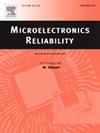Effect of stress interruption on TDDB lifetime during constant voltage stressing in metal-ferroelectric-insulator-semiconductor ferroelectric devices
IF 1.6
4区 工程技术
Q3 ENGINEERING, ELECTRICAL & ELECTRONIC
引用次数: 0
Abstract
TDDB lifetime is an important reliability metric for ferroelectric devices, which is dependent on the complex interplay between a multitude of factors. Mechanisms such as oxygen vacancy generation, charge trapping and detrapping are relevant in the degradation physics of hafnia-based ferroelectric devices. A large difference in Time-to-Failure in Metal – Ferroelectric – Insulator - Semiconductor (MFIS) devices in response to Interrupted and Uninterrupted Constant Voltage Stressing was found, which underscores the significance of stress interruption on the degradation physics occurring in the device. However, the effect of interruptions during stressing in MFIS devices is relatively unexplored. This work aims to pave the way for the development of stressing schemes for the evaluation of ferroelectric devices with closer adherence to practical operating conditions.
求助全文
约1分钟内获得全文
求助全文
来源期刊

Microelectronics Reliability
工程技术-工程:电子与电气
CiteScore
3.30
自引率
12.50%
发文量
342
审稿时长
68 days
期刊介绍:
Microelectronics Reliability, is dedicated to disseminating the latest research results and related information on the reliability of microelectronic devices, circuits and systems, from materials, process and manufacturing, to design, testing and operation. The coverage of the journal includes the following topics: measurement, understanding and analysis; evaluation and prediction; modelling and simulation; methodologies and mitigation. Papers which combine reliability with other important areas of microelectronics engineering, such as design, fabrication, integration, testing, and field operation will also be welcome, and practical papers reporting case studies in the field and specific application domains are particularly encouraged.
Most accepted papers will be published as Research Papers, describing significant advances and completed work. Papers reviewing important developing topics of general interest may be accepted for publication as Review Papers. Urgent communications of a more preliminary nature and short reports on completed practical work of current interest may be considered for publication as Research Notes. All contributions are subject to peer review by leading experts in the field.
 求助内容:
求助内容: 应助结果提醒方式:
应助结果提醒方式:


